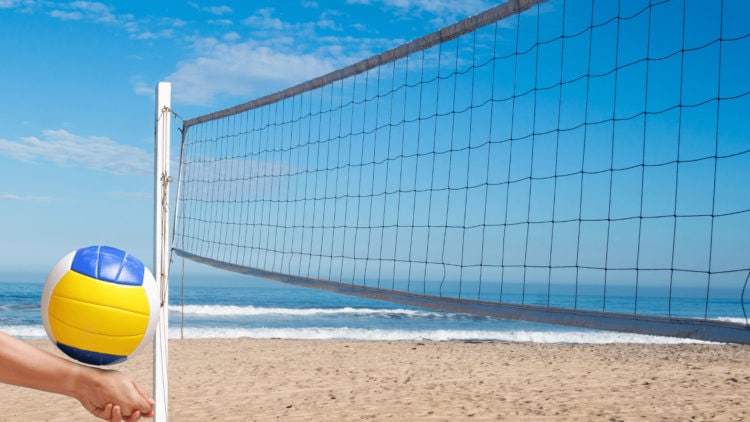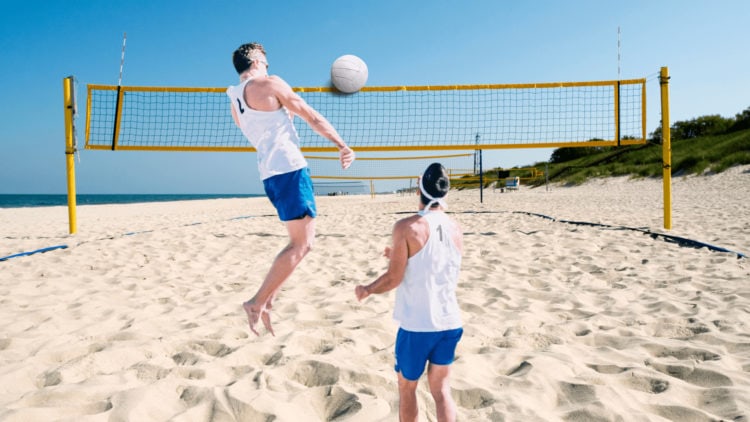
OBJECTIVE OF BEACH VOLLEYBALL: Players must hit a ball onto the opposing team’s side of the net in a fashion that renders them unable to successfully volley the ball back over the net.
NUMBER OF PLAYERS: 4 players, 2 on each team
MATERIALS: Volleyball net, volleyball, sand court
TYPE OF GAME: Sport
AUDIENCE: 8+
OVERVIEW OF BEACH VOLLEYBALL
Beach volleyball is an outdoor version of the traditional game of indoor volleyball, uniquely featuring two teams of only 2 players, who compete on a court of sand. Recreationally, beach volleyball is popularly played on actual beaches, although most professional beach volleyball competitions occur inside sand-filled stadiums.
Despite originating on the beaches of Hawaii in 1915, the modern doubles-based the beach volleyball rules weren’t conceptualized until the 1930s, when four friends grew impatient while waiting for the remainder of their six-person teams to show up. After seeing how well the game played with just two players on each side of the net, the sport of beach volleyball was forever revolutionized.
Nowadays, people play beach volleyball around the entire globe ,and it is especially popular in European countries. The sport originated in the United States, and American troops throughout World War I are thought to be responsible for introducing the sport to the European continent.
SETUP
EQUIPMENT AND COURT
The Volleyball: A spherical ball that consists of a rubber bladder surrounded by an exterior of water-resistant leather. This ball should be about 26 inches in circumference and weighs between 8.3 and 9 ounces.
The Net: A volleyball net should be 7’11 ⅝” tall or nearly eight feet off the ground for matches between men. For women, this net height should be six-and-a-half inches lower at 7’4 ⅛”.
The Court: A beach volleyball court should be 52’6” in length and 26’3” in width. This court size should naturally hold between 200-600 tons of sand. This includes yours and your opponent’s court.
POSITIONS
Due to the small team size, there are no positions in beach volleyball, as both players will need to be competent at defending, attacking, and serving.
GAMEPLAY

A beach volleyball match begins with one team serving to the other, similar to the game of tennis. Players then rally the ball back and forth while keeping it in bounds and off the ground.
SERVING
A coin toss at the start of a game, whichever team wins serves first. Then, as is the case for the rest of the match, the team that scores a point is the team that serves next.
If the serving team scores a point, the same player serves again. If the receiving team scores a point, they are given the next serve.
After each possession change, the player who didn’t serve last time must serve until they concede another point.
SCORING
To score points, the teams must knock the ball onto their opponent’s play area within the out-of-bounds lines without the other team legally hitting the ball back before it touches the ground.
Beach volleyball matches can be played in a best-of-one or best-of-three format. However, regardless of the number of games played, the scoring rules remain consistent:
- One point is scored each time the ball touches the ground on the opposing team’s side of the court or the opposing team is unable to successfully return the ball over the net.
- A game is won by the first team that reaches 21 points.
- Teams switch sides of the net after 7 total points are scored.
Although 21 points is the goal for each team, a team must win by at least two points. This means a 21–20 score would not result in a win, but a 21–19 would. This two-point differential has no cap – this score could theoretically go on forever until a team has a two-point lead.
If a beach volleyball match is taken to a third game in a best-of-three series, the game is only played to 15 points instead of 21. Teams switch sides after 5 points are scored (instead of seven points) in these matches.
BEACH VOLLEYBALL RALLIES
A “rally” refers to the back-and-forth action of both teams hitting the ball over the net. A rally ends once the ball touches the ground or a referee calls a fault.
Just as in traditional volleyball, players must utilize special techniques to control the ball since they cannot catch it. The three main techniques used in volleyball include:
- The Pass: A “pass” is often used to “catch” and control the ball after it is hit over the net by the opposing team. A player gets underneath the ball and hits it upwards by using the underside of both of their forearms.
- The Set: A “set” is used to lightly hit the ball upwards in a way that sets up an accurate “attack” hit. With this touch, a player uses their finger tips to lightly direct the ball toward their teammate.
- The Attack: An “attack” hit is the touch used to direct the ball over the net. This hit is almost always performed when the ball is high in the air, allowing the player to “spike” the ball downwards over the net, making it more difficult for the opposing team to return the ball.
Since rallies can frequently become disorganized due to powerful attacks from the opponent, teams occasionally find themselves having to “pass” the ball over the net instead of using a lethal “attacking” hit.
IMPORTANT RALLY AND SCORING RULES

The following are specific rules regarding legal rallying and scoring procedures:
- Similarly to soccer, a ball is considered inbounds unless it touches the ground completely outside the playing field; a ball that lands on and touches the out-of-bounds court line is considered in-play.
- Each team is only allowed to touch the ball three times while the ball is on their side of the net. A fourth touch results in a point for the other team.
- Players are allowed to touch the ball with any part of their body; they can even kick the ball.
- A single player is not allowed to touch the ball two times in a row.
- Teams are not allowed to reach over the net when attempting to block the ball.
- A ball hit that is caught on the net is still in play until it touches the ground.
- A ball cannot be caught in any way, shape, or form.
END OF GAME
A team wins by leading their opponent by at least two points and scoring at least 21 points (15 for tiebreaker matches).
- 30 GAMES TO PLAY OVER TEXT - April 22, 2024
- 20+ FREE PRINTABLE BABY SHOWER GAMES - April 16, 2024
- 20+ College Party Games for the Best Night Ever! - April 2, 2024